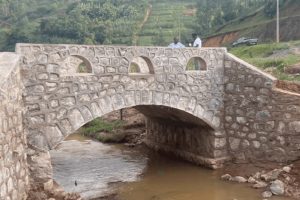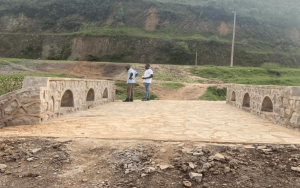Introduction:
Sustainable infrastructure plays a critical role in economic growth and improving access to essential services. In rural communities, where modern infrastructure is often lacking, innovative solutions like stone arch bridges offer a durable, cost-effective way to connect people to opportunities. At Partners in Engineering for Impact Sustainability (PEIS), we are pioneering the construction of stone arch bridges, which provide safe and reliable passage while promoting environmental sustainability.
The Need for Sustainable Infrastructure in Rural Areas:
In developing countries like Rwanda, many rural communities face isolation due to inadequate infrastructure. Without reliable bridges and roads, access to schools, healthcare, and markets becomes difficult. The need for sustainable infrastructure is pressing, and innovative solutions are required to address these challenges. Stone arch bridges offer a low-cost, low-maintenance option that meets the needs of these communities.
What Makes Stone Arch Bridges a Sustainable Choice?
- Durability: Built from local materials like stone and sand, stone arch bridges are designed to last for decades, reducing the need for frequent repairs.
- Low Environmental Impact: Unlike steel or concrete, stone arch bridges have a smaller carbon footprint, using local materials and traditional construction methods.
- Cost-Effective: Stone arch bridges require fewer resources, resulting in up to 70% lower investment costs than conventional bridges.
Case Study: Transforming Rural Villages in Rwanda
One of our most impactful projects was the construction of a stone arch bridge in a rural village in Rwanda. Before the bridge was built, villagers had to cross a dangerous river to access the nearest town. After constructing the stone arch bridge, not only did travel times decrease significantly, but the community also saw an increase in trade, access to education, and healthcare services. The bridge continues to stand as a testament to PEIS’s commitment to sustainable infrastructure.
The Long-Term Benefits of Stone Arch Bridges:
Stone arch bridges are more than just functional—they become part of the community’s identity, fostering a sense of pride and ownership. The long-term benefits include:
- Increased Connectivity: Bridges connect rural villages to urban centers, enhancing access to markets, schools, and medical facilities.
- Economic Growth: Improved transportation leads to the expansion of local economies as farmers and artisans can bring their products to market more efficiently.
- Resilience Against Climate Change: Stone arch bridges are highly resistant to floods and erosion, making them ideal for regions prone to extreme weather.
PEIS’s Vision for Sustainable Infrastructure in Africa:
At PEIS, we envision a future where every rural community in Africa has access to durable, eco-friendly infrastructure. Our mission is to continue building low-cost, sustainable stone arch bridges and exploring other innovative construction methods to enhance community connectivity and economic growth. Through partnerships with governments and NGOs, we aim to replicate the success we’ve seen in Rwanda across other regions.
Conclusion:
Sustainable bridges like the ones built by PEIS are transforming rural communities, improving access to vital services, and driving economic development. As the demand for cost-effective infrastructure grows, stone arch bridges are emerging as a viable solution for developing nations.
If you’re interested in learning more about how PEIS can help with sustainable infrastructure projects or would like to partner with us, contact us today.
Introduction
In the world of engineering, tackling challenging terrains is akin to solving a complex puzzle. From rugged mountains to unstable sands, the ability to develop effective solutions for these environments is crucial for successful infrastructure projects. This article delves into some of the most innovative engineering solutions designed to overcome the obstacles presented by difficult terrains. We’ll explore cutting-edge technologies, case studies, and future trends shaping the field.
Understanding Challenging Terrains
What Constitutes a Challenging Terrain?
Challenging terrains encompass a variety of difficult environments including:
- Mountainous Regions: Steep gradients and unstable soil.
- Desert Landscapes: Shifting sands and extreme temperatures.
- Swampy Areas: High water tables and soft ground.
- Seismic Zones: Areas prone to frequent earthquakes.
Why Engineering Solutions Are Necessary
Engineering solutions are vital to ensure:
- Safety: Preventing accidents and ensuring structural stability.
- Efficiency: Reducing project time and costs.
- Sustainability: Minimizing environmental impact and ensuring long-term viability.
Innovative Engineering Solutions
1. Geosynthetics in Civil Engineering
What Are Geosynthetics?
Geosynthetics are materials used to enhance soil properties and improve stability. They include:
- Geotextiles: Fabrics that reinforce soil and prevent erosion.
- Geogrids: Materials that provide structural support to the soil.
Applications in Challenging Terrains
- Mountain Roads: Reinforcing slopes to prevent landslides.
- Desert Construction: Stabilizing sandy soils for building foundations.
2. Adaptive Pavement Technologies
Self-Healing Asphalt
Self-healing asphalt contains additives that allow it to repair minor cracks and extend the lifespan of roads. This technology is particularly useful in areas with extreme temperatures.
Temperature-Responsive Pavements
These pavements adjust their properties based on temperature changes, providing better traction and durability in diverse climatic conditions.
3. Advanced Drilling Techniques
Horizontal Directional Drilling (HDD)
HDD allows for the installation of pipes and cables underground without disturbing the surface. This is essential for:
- Urban Areas: Minimizing disruptions in densely populated cities.
- Mountainous Regions: Avoiding surface excavation in rugged terrains.
Micro-Tunneling
Micro-tunneling involves drilling small-diameter tunnels, which is advantageous for:
- Swampy Areas: Minimizing disturbance to the fragile ecosystem.
- Urban Infrastructure: Installing utilities without extensive surface excavation.
4. Sustainable Building Materials
Earthquake-Resistant Materials
Materials such as cross-laminated timber (CLT) and reinforced concrete are designed to withstand seismic activities, providing safety in earthquake-prone regions.
Desert-Friendly Materials
Materials that reflect heat and insulate against extreme temperatures are crucial for sustainable construction in deserts.
5. Robotics and Automation
Drones for Terrain Analysis
Drones equipped with advanced sensors and imaging technology provide detailed terrain analysis, aiding in planning and design.
Robotic Construction
Robots can perform tasks such as excavation and material placement in challenging environments, improving precision and efficiency.
Case Studies
Case Study 1: The Gotthard Base Tunnel
The Gotthard Base Tunnel in Switzerland is a marvel of modern engineering, showcasing:
- Tunnel Boring Machines (TBMs): Used to bore through the Alps.
- Innovative Ventilation Systems: To manage air quality and temperature.
Case Study 2: The Dubai Palm Islands
Dubai’s Palm Islands project involved:
- Land Reclamation Techniques: Creating islands from the sea using advanced dredging technology.
- Seawalls and Breakwaters: Protecting against erosion and storm surges.
Future Trends in Engineering Solutions
Smart Materials and Structures
Smart materials that adapt to environmental conditions are on the horizon. These materials could revolutionize how we build and maintain infrastructure in challenging terrains.
Artificial Intelligence and Machine Learning
AI and machine learning are enhancing predictive maintenance and optimizing design processes, making it easier to manage complex terrains.
Green Engineering Practices
The focus is shifting towards sustainable and eco-friendly solutions that reduce environmental impact and promote harmony with nature.
Conclusion
Innovative engineering solutions for challenging terrains represent a blend of creativity, technology, and practical know-how. From advanced materials and drilling techniques to robotics and sustainable practices, these solutions are paving the way for successful infrastructure projects in some of the most difficult environments. As technology continues to evolve, the possibilities for overcoming terrain challenges will expand, offering even more efficient and sustainable options for engineers around the world.



